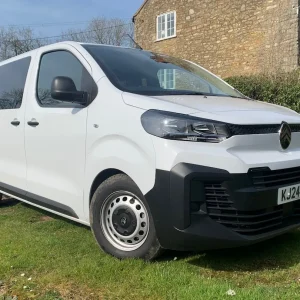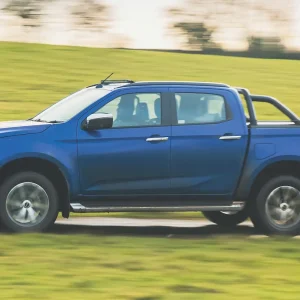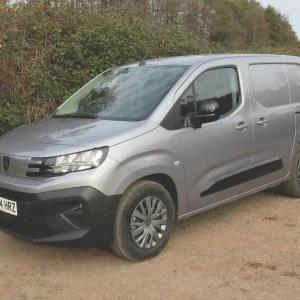The third generation of Vauxhall’s car-derived Corsavan arrived in showrooms in March before getting a public showing at the CV Show in April.
Since its introduction in 1982, the manufacturer claims to have sold 34,000 examples of the little runaround, but, more significantly, it shifted 2400 units of the previous generation model last year – its best showing since the pre-recession year of 2008.
Although there may be some disruption with the change over to the new van, Vauxhall is confident it can build on this figure going forward to get closer to the 4000-odd sales registered annually by its only true rival – the Ford Fiesta Van.
“It would be good to eat into that lead,” says LCV head Steve Bryant.
After a difficult few years during which the brand first lost its customary position as the second best selling LCV manufacturer behind Ford and then slipped further down the ratings, perhaps as a result of moving away from lower value business, Bryant feels Vauxhall is once more on an upward curve. He puts this down to the high profile launch of the UK-built Vivaro medium van in 2014 putting the Griffin brand back on the radar.
In February Vauxhall grew year-on-year sales by 66% to 2082 and was up by more than 10% in the year-to-date on 4117 units, according to the SMMT.
Pre-VAT on-the-road prices for the new car-derived van start from £11,858 for the entry-level 1.2-litre 70hp petrol Corsavan, but this version will be extremely low volume, accounting for only about 2% of sales.
There is a steep step up to £13,108 for the 1.3 75hp diesel version with Start/Stop, a move up to £13,558 for the 1.3 95hp Start/Stop Ecoflex, which is the most economical derivative with official CO2 emissions of 87g/km and combined cycle fuel consumption of 85.6mpg and peak at £14,558 for the 1.3 95hp Corsavan Sportive with Start/Stop. Twop trim levels – Corsavan and Sportive – are available.
The Sportive is £775 more expensive than the previous generation flagship but Vauxhall says this is because it is considerably more refined and comes with a lot more kit.
LCV brand manager Brad Millar says: “Customers want high-end options, on the old Colsavan they were more rudimental.”
Once the cost of the number plates, delivery to dealer, 12 months VED and new vehicle first registration fee, which make up the recommended retail price (RRP) are subtracted the new Corsavan is priced from £10,995 to £13,695 compared to the previous line-up that went from £10,920 to £12, 295.
The base prices for the Ford Fiesta Van go from £11,180 to £13,450.
All engines in the Corsavan are Euro6 compliant and for the next three years, under the current 6.1 regulation, the diesel drivetrains, which all come with stop/start, do not require the Adblue exhaust additive to meet the requirement. In 2018, however, when the 6.2 version takes over, the engines will require Adblue. Millar admits topping up with Adblue will be a hassle for operators, particularly owner-drivers and small businesses. The liquid is perishable so cannot be stored for more than two years and topping up times are likely to come around more frequently than visits to the workshop for servicing.
Mandatory ESP on the new Corsavan brings with it standard safety features such as straight line stability control, cornering brake control, drag torque control, brake assist system, active rollover protection, hydraulic brake fade assist and hill start assist.
All models also get six airbags, electric windows and door mirrors, an audio system with aux-in, DAB and Bluetooth, a tyre pressure monitoring system and speed sensitive power steering.
Customers opting for the Sportive trim level get extra kit including air conditioning, 16-inch alloy wheels, sports seats, steering wheel-mounted audio controls and cruise control with a speed limiter function.
Vauxhall has made a raft of new options available with the new Corsavan such as electronic climate control, a Technical Pack with forward collision alert, lane departure warning, rear view camera, traffic sign recognition and a following distance indicator. An upgraded seven-inch touchscreen infotainment system is available as are black alloys, rear parking sensors and a Winter Pack with heated seats and steering wheel.
Vauxhall claims the Corsavan offers 12% more carrying capacity than its key rival, the Ford Fiesta Van, with a maximum payload of 571kg compared to the Fiesta Van’s 508kg.
The brand also highlights the Corsavan’s service intervals of 20,000 miles/12 months, next to its competitor’s 12,500/12 months schedule.
Vauxhall offers four years’ zero per cent APR (annual percentage rate) finance, four years’ free servicing, four years’ roadside assistance and four years’ warranty.
“Vauxhall’s all-new Corsavan is stylish, comfortable and affordable to run,”Bryant says. “It will hold massive appeal to van drivers, small businesses, fleet decision makers and company drivers alike.”
The new model is a sleeker, more stylish looking small van with a bit more edge to it than its somewhat meek and inoffensive predecessor.
It features the Vauxhall family face with “eagle eye” –shaped headlights incorporating the brand’s wing-shaped LED daytime running lights, which are a standard fit on the new van. The trapezoidal grille is lower and sportier and comes with a chrome bar beneath the Vauxhall Griffin badge.
From the side the blade signature on the doors mirrors the arched window line, which drops smoothly from the centre to the panelled side rear window.
The rear of the van also gets a new look. Horizontal split tail lights widen the van and give it a sturdier stance than before.
We got behind the wheel of the generously specified Corsavan Sportive 1.3 CDTi 95hp S/S. The interior is stylish and reminiscent of a sports hatchback with the appearance of the decent quality black plastic enhanced by a horizontal red plastic bar that spans the length of the dashboard.
The control buttons are well placed and simple to operate and the gear stick is chunky and within comfortable reach. Storage provisions are reasonable for a small van and include a lidded glove box, although this is not lockable, useful rather than token-effort bins in the doors and a total of four cup holders – the ones further back probably a legacy of the passenger car its based on. A central tray beneath the dash contains plugs for USB and ipods.
Curiously, the vanity mirror in our test van was installed in the driver’s sun visor while the passenger doesn’t get one. The steering wheel is pleasingly small and thick and comes with a leather cover, which is exclusive to Sportive although the audio controls mounted on it are also standard on Ecoflex models.
The steering wheel column is adjustable for rake and reach and combined with the height adjustable driver’s seat it is easy to find the best driving position.
There is an impressive amount of legroom too so even the tallest occupants are not likely to feel cramped.
On the road the Sportive is lively and nimble and likely to appeal to customers looking for an engaging drive as well as a little load lugger.
The Sportive gets a six-speed manual gearbox, while the rest of the range has to make do with five, and this works harmoniously with the precise and responsive steering.
In fact the Corsavan in Sportive trim is now fit to give the Fiesta Van a run for its money in terms of performance.
Oddly, bearing in mind its high specification level overall, the Sportive does not get reversing sensors as standard – these come as a £250 option and satellite navigation will set you back £750.
The Sportive gets a space saver spare wheel while the Corsavan trim gets a full-size spare. Nevertheless the amount of kit on the flagship model, such as the air con system accounts for it having a slightly lower payload than standard versions: 543kg compared to 571kg on the diesels and 560kg on the petrol.
The load area is accessed via a rear hatch tailgate and contains four tie-down points and a wiped-clean rubber floor. The cabin is protected by a half-height metal bulhead with a mesh top half that comes as a £25 extra.
We also drove the 95hp Ecoflex Corsavan – the most economical model in the line-up with official fuel economy of 85.6mog and CO2 of 87g/km. The Ecoflex dashboard comes with a trip computer giving “eco scoring” such as instant and average fuel consumption. The interior is plainer than on the Sportive and the five-speed ‘box inclines the van towards a more sedate drive. Like the Sportive the Ecoflex also gets USB connection with ipod control and steering-wheel mounted control as standard. As well as Rear Park Assist (£250) the test van also included air conditioning for £425, the vertical load restraint net for £25 and the rubber floor mat for the load bay for £45.
All diesel models get an Eco button, which can save fuel by reducing torque if it is not required for heavy loads.
Bryant says Sportive models take about 25% of Corsavan sales and adds that overall, retail customers (fleets of below 25 vans) account for about 60% more sales than fleets.
Verdict
The new Corsavan has made a big step up compared to its predecessor and will appeal to customers who want something more engaging than a practical city van.
Vauxhall Corsavan Sportive 1.3CDTi 95hp S/S
Price (exc VAT) £13,695
Price range (exc VAT) £10, 995-£13,695
Insurance group 2E
Warranty 3yrs/60,000 miles
Service intervals 20,000 miles
Load length 1257mm
Load width (min/max) 969mm/1264mm
Load bay height 921mm
Gross payload 543kg
Load volume 0.92m3
Engine size/power 1248cc/95hp
On sale March
Combined fuel economy 74.3mpg
CO2 101g/km





